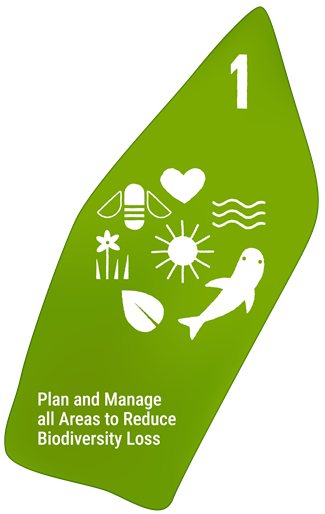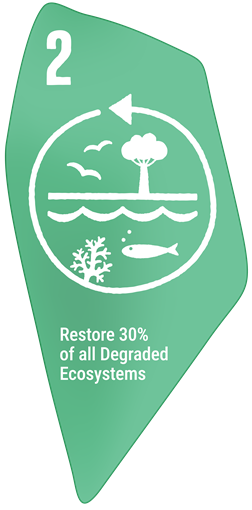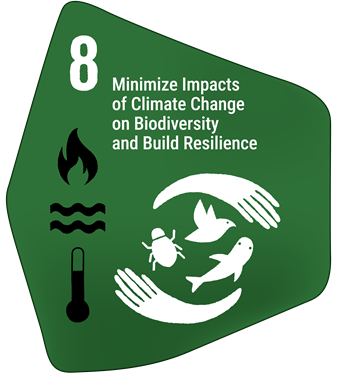 Photo by Pavlos Evangelidis
Photo by Pavlos Evangelidis
World Oceans Day-- 8 June 2024
The ocean sustains life on our planet and is central to the healthy functioning of nearly all of Earth’s processes. It is the world’s largest ecosystem, home to nearly one million known species, and contains tremendous untapped potential for scientific discovery. Unexplored ocean ecosystems hold undiscovered species and important new medicines, vaccines, food, energy, and more.
But ocean ecosystems are under threat from climate change, pollution and overexploitation among other drivers of biodiversity loss. If we don’t act now, we won’t have any healthy ocean ecosystems left to explore.
Work under the Convention on Biological Diversity to describe ecologically or biologically significant marine areas has enhanced our understanding for parts of the ocean that are most crucial to healthy, functioning ecosystems.
But science and knowledge will only take us part of the way. We need to act on this knowledge. We have seen that well-structured approaches to conservation and sustainable use clearly deliver strong outcomes, especially when driven by those people and communities that live and work with ocean ecosystems every day.
On World Oceans Day – and every day – everyone is encouraged to be part of the Plan; The Biodiversity Plan.
The Kunming-Montreal Global Biodiversity Framework, or The Biodiversity Plan, was developed to be a catalyst to mobilize a whole-of-society approach.
It seeks to uncover the enormous amount of experiences, lessons, knowledge, and skills across the world that can help to solve many of the problems that we face.
It speaks to the entirety of the global community: from the office of a Minister trying to find a way for her country to reduce poverty without destroying sensitive ecosystems, to a local fisherman worried about dwindling fish stocks and how he will provide for his family, and to children worried about their future and what kind of planet will be left for them.
Every one of us has a part to play – businesses, governments, young people, indigenous peoples and local communities, you, and me.
More information:
Related Targets in The Biodiversity Plan
Ensure that all areas are under participatory, integrated and biodiversity inclusive spatial planning and/or effective management processes addressing land- and sea‑use change, to bring the loss of areas of high biodiversity importance, including ecosystems of high ecological integrity, close to zero by 2030, while respecting the rights of indigenous peoples and local communities.
Why is this target important?
Land-use and sea-use change are major direct drivers of biodiversity loss. Land-use change has had the largest relative negative impact on terrestrial and freshwater ecosystems since 1970, with agricultural expansion being the most widespread form of land-use change. Marine and coastal ecosystems have been significantly affected by human activities as well, with research demonstrating increasing cumulative impacts of human activities in more than 60 per cent of the ocean.
Increasing demands and conflicting uses of land, inland water and ocean space and resources underscore the need for cross-sectoral approaches that allow for the consideration of multiple interests, values and types of use. Integrated spatial planning and/or effective management processes allow countries to analyze and then effectively allocate the spatial and temporal distribution of activities in each environment to achieve various social, ecological and economic objectives. Integrated and participatory spatial planning helps bring together all stakeholders for a particular space and thereby ensure the prioritization and proper allocation of various activities and thereby balance the need to safeguard nature, while advancing sustainable socioeconomic development and ensuring food security and human well-being. The ecosystem approach as well as the many examples of guidance and experience in implementing this approach also provide a strong basis for this target.
Links to other elements of the Biodiversity Plan and other frameworks and processes.
- Actions to reach Target 1 should take into account all of the considerations for implementation identified in section C of the Kunming-Montreal Global Biodiversity Framework.
- Progress towards this target will support the attainment of goals A and B of the Kunming-Montreal Global Biodiversity Framework. In addition, progress towards this target will directly support the attainment of targets 2, 3, 5, 10 and 12 of the Framework. Conversely, progress towards targets 14, 19, 20, 21, 22 and 23 will help to reach Target 1.
- Target 1 addresses issues that were previously addressed by Aichi Biodiversity Target 5.
- Elements of Target 1 are also addressed in the targets of the Sustainable Development Goals, including targets 14.2, 15.1, 15.2, 15.5 and 15.9.

Ensure that by 2030 at least 30 per cent of areas of degraded terrestrial, inland water, and coastal and marine ecosystems are under effective restoration, in order to enhance biodiversity and ecosystem functions and services, ecological integrity and connectivity.
Why is this target important?
Habitat degradation is the result of human-induced processes that result in a decline in biodiversity, ecosystem functions and services, and resilience and can occur in terrestrial, freshwater or marine and coastal ecosystems. Because degradation can take many forms and be measured in different ways, there are varying estimates on the amount of degraded habitat globally. However, estimates suggest that between 20 and 40 per cent of the global land area alone could be considered degraded, affecting the well-being of at least 3.2 billion people
The main direct drivers of land degradation are the expansion of crop and grazing lands into natural areas, unsustainable agricultural and forestry practices, climate change, and, in specific areas, urban expansion, infrastructure development and extractive industry. Habitat loss through transformation and the decline in the suitability of the remaining habitat through degradation are the leading causes of biodiversity loss. Ecosystems affected by land degradation mainly include forests, rangelands and wetlands. Wetlands are particularly degraded, with 87 per cent lost globally in the last 300 years, and 54 per cent since 1900. Marine ecosystems are experiencing high rates of habitat loss and degradation as well, particularly along coastlines, mangrove forests and coral reefs.
Links to other elements of the Biodiversity Plan and other frameworks and processes.
- Actions to reach Target 2 should take into account all of the considerations for implementation identified in section C of the Kunming-Montreal Global Biodiversity Framework.
- Progress towards this target will support the attainment of goals A and B of the Kunming-Montreal Global Biodiversity Framework. In addition, progress towards this target will directly support the attainment of targets 3, 8, 11 and 12 of the Framework. Conversely, progress towards targets 1, 14, 19, 20, 21, 22 and 23 will help to reach Target 2.
- Target 2 addresses issues that were previously addressed by Aichi Biodiversity Target 15
- Elements of Target 2 are also addressed in the targets of the Sustainable Development Goals, including targets 6.6, 14.2, 15.1 and 15.3
- Target 2 also links to processes under the United Nations Convention to Combat Desertification (UNCCD) related to land degradation neutrality and associated target setting, the Global Forest Goals and targets of the United Nations Strategic Plan for Forests developed under the United Nations Forum on Forests, Ramsar Resolution VII.17 as well as to the United Nations Decade on Ecosystem Restoration.

Ensure and enable that by 2030 at least 30 per cent of terrestrial and inland water areas, and of marine and coastal areas, especially areas of particular importance for biodiversity and ecosystem functions and services, are effectively conserved and managed through ecologically representative, well-connected and equitably governed systems of protected areas and other effective area-based conservation measures, recognizing indigenous and traditional territories, where applicable, and integrated into wider landscapes, seascapes and the ocean, while ensuring that any sustainable use, where appropriate in such areas, is fully consistent with conservation outcomes, recognizing and respecting the rights of indigenous peoples and local communities, including over their traditional territories.
Why is this target important?
Land-use and sea-use change are major direct drivers of biodiversity loss. Land-use change has had the largest relative negative impact on terrestrial and freshwater ecosystems since 1970, with agricultural expansion being the most widespread form of land-use change. Marine and coastal ecosystems have been significantly affected by human activities as well, with research demonstrating increasing cumulative impacts of human activities in more than 60 per cent of the ocean.
Increasing demands and conflicting uses of land, inland water and ocean space and resources underscore the need for cross-sectoral approaches that allow for the consideration of multiple interests, values and types of use. Integrated spatial planning and/or effective management processes allow countries to analyze and then effectively allocate the spatial and temporal distribution of activities in each environment to achieve various social, ecological and economic objectives. Integrated and participatory spatial planning helps bring together all stakeholders for a particular space and thereby ensure the prioritization and proper allocation of various activities and thereby balance the need to safeguard nature, while advancing sustainable socioeconomic development and ensuring food security and human well-being. The ecosystem approach as well as the many examples of guidance and experience in implementing this approach also provide a strong basis for this target.
Links to other elements of the Biodiversity Plan and other frameworks and processes.
- Actions to reach Target 1 should take into account all of the considerations for implementation identified in section C of the Kunming-Montreal Global Biodiversity Framework.
- Progress towards this target will support the attainment of goals A and B of the Kunming-Montreal Global Biodiversity Framework. In addition, progress towards this target will directly support the attainment of targets 2, 3, 5, 10 and 12 of the Framework. Conversely, progress towards targets 14, 19, 20, 21, 22 and 23 will help to reach Target 1.
- Target 1 addresses issues that were previously addressed by Aichi Biodiversity Target 5.
- Elements of Target 1 are also addressed in the targets of the Sustainable Development Goals, including targets 14.2, 15.1, 15.2, 15.5 and 15.9.

Minimize the impact of climate change and ocean acidification on biodiversity and increase its resilience through mitigation, adaptation, and disaster risk reduction actions, including through nature-based solutions and/or ecosystem-based approaches, while minimizing negative and fostering positive impacts of climate action on biodiversity.
Why is this target important?
Climate change is one of the main direct drivers of biodiversity loss. In addition to climate change, rising atmospheric carbon dioxide concentrations have also resulted in ocean acidification. Various mitigation, adaptation and disaster risk reduction measures, including nature-based solutions and/or ecosystem-based approaches, have the potential to increase the resilience of ecosystems and human livelihoods to the impacts of climate change, including reducing emissions from deforestation and other land-use changes, and by enhancing carbon sinks. These approaches can also deliver numerous social, economic and environmental co-benefits.
Links to other elements of the Biodiversity Plan and other frameworks and processes.
- Actions to reach Target 8 should take into account all of the considerations for implementation identified in section C of the Kunming-Montreal Global Biodiversity Framework.
- Progress towards Target 8 will help to reach goals A and B of the Kunming-Montreal Global Biodiversity Framework. Progress towards this target could also help to reach targets 2, 3, 4, 10, 11, and 12. Conversely, progress towards targets 1, 10, 14, 19, 20, 21, 22 and 23 would facilitate progress towards this target.
- Target 8 addresses issues previously addressed in Aichi Biodiversity Target 10.
- Elements of Target 8 are also addressed in the targets of the Sustainable Development Goals, including targets 13.1, 13.2 and 14.3.
- Target 8 is also relevant to work being undertaken under the Paris Agreement under the UNFCCC, as well as the Sendai Framework for Disaster Risk Reduction.

Ensure that areas under agriculture, aquaculture, fisheries and forestry are managed sustainably, in particular through the sustainable use of biodiversity, including through a substantial increase of the application of biodiversity friendly practices, such as sustainable intensification, agroecological and other innovative approaches contributing to the resilience and long-term efficiency and productivity of these production systems and to food security, conserving and restoring biodiversity and maintaining nature’s contributions to people, including ecosystem functions and services.
Why is this target important?
Agriculture, aquaculture, fisheries and forestry are globally important production systems that have varying impacts on ecosystems and biodiversity. The variety and variability of animals, plants and microorganisms used in these systems is an important aspect of biodiversity. Further, in many countries, activities associated with these production systems are important elements of human well-being and economic activity. However, the increasing demand for food, fibre and fuel is leading to increasing losses of biodiversity and ecosystem services, making sustainable management in these systems an urgent requirement. On the other hand, sustainable management not only contributes to biodiversity conservation but can also deliver benefits to production systems in terms of ecosystem services such as soil fertility, erosion control, enhanced pollination and reduced pest outbreaks, as well as contributing to the well-being and sustainable livelihoods of people engaged in agriculture, aquaculture, fisheries and forestry activities.
Links to other elements of the Biodiversity Plan and other frameworks and processes.
- Actions to reach Target 10 should take into account all of the considerations for the implementation identified in section C of the Kunming-Montreal Global Biodiversity Framework.
- This target will contribute to the attainment of goals A and B of the Kunming-Montreal Global Biodiversity Framework. Further progress towards this target will facilitate the attainment of targets 2, 4, 6, 7, 8, 9, 11 and 16. Conversely, the attainment of this target will be facilitated by actions to reach targets 1, 14, 17, 19, 20, 21, 22 and 23.
- Target 10 addresses issues previously covered by Aichi Biodiversity targets 6 and 7
- Elements of Target 10 are also addressed in the targets of the Sustainable Development Goals, including targets 2.3, 2.4, 12.1, 12.2, 14.7 and 15.2.
